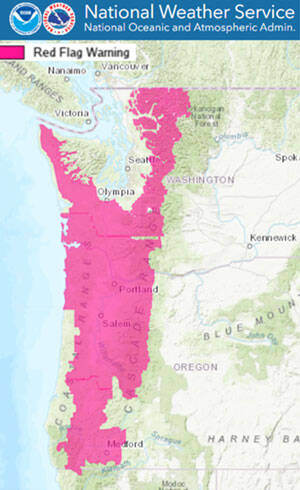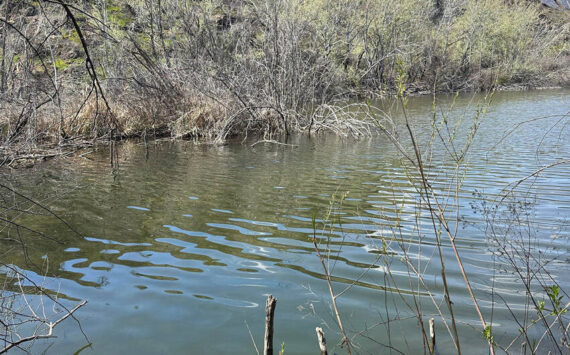A Red Flag Warning means that critical fire weather conditions are either occurring now or will shortly. These warnings are issued when specific criteria are met to create prime conditions for fast fire spread if a fire were to ignite.
“Today’s red flag warnings are in effect for extremely hot, dry, unstable weather west of the Cascade crest,” said Ian Rickert, Regional Fire Planner for the Pacific Northwest Region of the Forest Service. “The challenging fire weather conditions coincide with areas that are experiencing abnormally dry to severe drought. Several measures of fire danger show we are approaching new record highs on the west slope of the cascades and in the coast range. Together, the weather and fuel conditions create a situation that lends itself to extreme fire behavior.”
Local fire restrictions are typically implemented around long-term fuels and weather conditions. These restrictions have a lengthy review process and therefore, it is not possible to address short-term events (1-2 days) such as Fire Weather Watches and Red Flags. For this reason, during these types of events, visitors are encouraged to not only check for what local fire restrictions are in place but also consider alternatives to campfires, such as propane fire pits, which are allowed in most National Forests.
The Pacific Northwest has seen a significant increase in human-caused wildfires compared to previous years and the area covered by the warnings is extensive. Because of this, it is imperative to exercise caution with anything that can cause a spark, such as cigarettes, matches, and fireworks. It is also important to look up fire restrictions in your area and report any signs of fire immediately.
What to do:
- Stay informed about the latest weather and fire conditions in your area.
- Be prepared and keep a fire extinguisher or water source nearby in case of emergency.
- Be cautious with anything that can cause a spark, such as cigarettes, matches, and fireworks.
- Look up fire restrictions in your area and follow them.
- Report any signs of fire immediately.
- Consider a less risky option for a campfire, such as a propane fire pit.
- Ensure trailer chains are properly secured and do not drag on the ground where they can spark and cause wildfires.
What NOT to do:
- Do not throw cigarettes or matches out of a moving vehicle.
- Do not use fireworks or other pyrotechnics.
- Do not leave outdoor fires unattended, even for a short period.
- Do not park vehicles in tall, dry grass.
“Understanding Red Flag warnings is not just a matter of awareness; it’s a commitment to safeguarding our communities and landscapes,” said Jacob Gear, Regional Fire Prevention Coordinator for the Pacific Northwest and Alaska Regions of the Forest Service. “These warnings aren’t just signals; they are calls to action, urging us to become stewards of prevention, protecting lives, homes, and the beauty that surrounds us.”
The Forest Service encourages residents to follow the recommendations of the National Weather Service and take proactive measures to prevent wildfires during this time of increased fire danger.
Additional information can be found here: https://gacc.nifc.gov/nwcc/predict/weather.aspx.
Visit the website and/or Facebook page for the National Forests you plan to visit for the latest information on local fire restrictions.
To learn more about how to prevent human-caused fires, visit https://www.fs.usda.gov/main/r6/fire-aviation/prevention.
For more information about the USDA Forest Service visit https://www.fs.usda.gov.







